|
Chapter Five
SUMER: LAND OF THE
GODS
EN.LIL.... Second most Powerful God.... First Son of Anu.
"His Name meant "lord of the airspace". He was born at his fatherís
"Heavenly Abode." But at some point in the earlier times he
descended to Earth, and was thus the principal God of Heaven and
Earth.
"....Enlil presided over the meetings alongside his father. When the
gods met for Assembly on Earth, they met at Enlilís court in the
divine precinct of Nippur, the city dedicated to Enlil and the site
of his temple, the E.KUR ("house which is like a mountain").
"Not only the Sumerians but the very gods of Sumer considered
Enlil
supreme. They called him Ruler of All the Lands, and made it clear
that "in Heaven - he is the Prince; on Earth - he is the Chief." His
"word (command) high above made the Heavens tremble, down below made
the Earth quake."
"Enlil, according to Sumerian beliefs, arrived on Earth well before
Earth became settled and civilized. A "Hymn to Enlil, the
All-Beneficent recounts the many aspects of society and civilization
that would not have existed had it not been for Enlilís instructions
to "execute his orders, far and wide."
No cities would be built, no settlements founded;
No stalls would be built, no sheepfolds erected;
No king would be raised, no high priest born.
"The Sumerian texts also stated that
Enlil arrived on Earth before
the "Black-Headed-People"- the Sumerian nickname for
Mankind - were
created. During such pre-Mankind times, Enlil erected
Nippur as his
center, or "command post" at which Heaven and Earth were connected
through some "bond." The Sumerian texts called this bond
DUR.AN.KI
("bond heaven-earth")....
"In those early days, when gods alone inhabited
Nippur and Man had
not yet been created Enlil met the goddess who was to become his
wife, SUD ("the nurse")....
"After she became his wife
Enlil bestowed her the name NIN.LIL
("lady of the airspace")....
"Apart from being chief of the gods,
Enlil was also deemed the
supreme Lord of Sumer (sometimes simply called "The Land") and its
"Black-Headed-People."
"The Sumerians revered
Enlil out of both fear and gratitude.
"God of Heaven and Earth, Firstborn of Anu, Dispenser of Kingship,
Chief Executive of the Assembly of the Gods, Father of Gods and Men,
Granter of Agriculture, Lord of the Airspace - these were some of
the attributes of Enlil that bespoke his greatness and powers. His
"command was far reaching," his "pronouncements unchangeable"; he
"decreed the destinies." He possessed the "bond heaven-earth" and
from his "awesome city Nippur" he could "raise the beams that search
the hearts of all the lands" - "eyes that could scan all the lands."
"As we go along, we shall see the central roll that Enlil played in
divine and mortal affairs on Earth, and how his several sons battled
among themselves and with others for the divine succession,
undoubtedly giving rise to the later tales of the battles of the
gods.
EN.KI, Third Great God
of Sumer... Lord Bright Eye...
"He was another son of Anu, he bore two names, E.A and EN.KI. Like
his brother Enlil, he, too, was a God of Heaven and Earth, a deity
originally of the heavens, who had come down to Earth....
"...E.A (the name meant literally "house-water") who was a master
engineer, planned and supervised the construction of canals, the
diking of the rivers, and the draining of the marshlands. He loved
to go sailing on these waterways, and especially in the marshlands.
The waters, as his name denoted were indeed his home. He built his
"great house" in the city he had founded at the edge of the
marshlands, a city appropriately named HA.A.KI ("place of the
water-fishes"); it was also known as E.RI.DU ("home of going
afar")....
"....The earliest Sumerian cylinder seals depicted
Ea as a deity
surrounded by flowing streams that were sometimes shown to contain
fish. The sea associated Ea with the Moon (indicated by its crescent) an association stemming
perhaps from the fact that the Moon caused the tides of the seas. It
was no doubt in reference to such an astral image that Ea was given
the epithet NIN.IGI.KU ("lord bright-eye").
"....Turning from the seas and rivers to the dry land,
Ea claimed
that it was he who "directed the plow and the yoke.... opened the
holy furrows.... built the stalls.... erected sheepfolds."
Continuing, the self adulatory text (named by scholars "Enki and the
World Order") credited the god with bringing to Earth the arts of
brick-making, constructions of dwellings and cities, metallurgy and
so on.
"Presenting the deity as Mankindís greatest benefactor, the god who
brought about civilization, many texts also depicted him as
Mankindís chief protagonist at the councils of the gods. Sumerian
and Akkadian Deluge texts, on which the biblical account must have
drawn, depict Ea as the god who - in defiance of the decision of the
Assembly of the Gods - enabled a trusted follower (the Mesopotamian
"Noah") to escape the disaster.
"Indeed, the Sumerian and Akkadian texts, which (like the Old
Testament) adhered to the belief that a god or the gods created Man
through a conscious and deliberate act, he outlined the method and
the process by which Man was to be created. With such affinity to
the "creation" or emergence of Man, no wonder that it was
Ea who
guided Adapa - the "model man" created by Eaís "wisdom" - to the
abode of Anu in the heavens, in defiance of the godís determination
to withhold "eternal Life" from Mankind.
"Was
Ea on the side of Man simply because he had a hand in his
creation, or did he have other, more subjective motives? As we scan
the record, we find that invariably Eaís defiance - in mortal and
divine matters alike - was aimed mostly at frustrating decisions or
plans emanating from Enlil.
"Enlil, by all records, the son of
Anu and his official consort
Antu, was the legal firstborn. But the anguished cry of Enki: "I am
the fecund seed.... I am the first born son of Anu," must have been
a statement of fact. Was he then born to Anu, but by another goddess
who was only a concubine?
"Though Enki appears to have accepted
Enlilís succession
prerogatives, some scholars see enough evidence to show a
continuing power struggle between the two gods.
"....At some point, it seems,
Enki decided that there was no sense
to his struggle for the Divine Throne, and he put his efforts into
making a son of his - rather than a son of Enlil - the third
generation successor. This he sought to achieve, at least at first,
with the aid of his sister NIN.HUR.SAG ("lady of the mountainhead").
"She, too, was a daughter of Anu, but evidently not by
Antu, and
therein lay another rule of succession
But Enki had a daughter, instead of a son, from Ninhursag.
"....According to the Sumerian texts,
Man was created by Ninhursag, following processes and formulas devised by
Enki. She was the chief nurse, the one in charge of medical facilities, it
was in that role that the goddess was called NIN.TI ("lady life").
"As giver of life to gods and Man alike, Ninhursag was spoken as the
Mother Goddess. She was nicknamed "Mammu" - the forerunner of our
"mom" or "mamma"- and her symbol was the "cutter"- the tool used in
antiquity by midwives to cut the umbilical cord after birth.
"Enlil,
Enkiís brother and rival, did have the good fortune to
achieve such a "rightful heir" by his sister Ninhursag; the youngest
of the gods upon Earth who was born in the heavens, his name was
NIN.UR.TA ("lord who completes the foundation").
".....The ancient portraits of
Ninurta showed him holding a unique
weapon - no doubt the very one which could shoot "bolts of light." He was
invoked in a battle with ZU ("wise"), who had illegally
captured the insignia and objects Enlil had held as Chief of the
Gods.
At the entrance of the sanctuary,
which he had been viewing,
Zu awaits the star of day,
As Enlil was washing with pure water -
his crown having been removed
and deposited on the throne -
Zu seized the Tablets of Destinies in his hands,
took away the Enlilship.
"As Zu fled in his
MU (translated "name" but indicating a
flying
machine) to a faraway hideaway, the consequences of his bold act
were beginning to take effect.
ZU.... Who was he? "Was
he a Mythological bird"?
"Evidently he could fly. But so can any man today who takes a plane,
or any astronaut who goes up in a spaceship. Ninurta too could fly,
as skillfully as Zu (and perhaps better). But he himself was not a
bird of any kind, as his many depictions, by himself or with his
consort BA.U (also called GU.LA), made abundantly clear. Rather, he
did his flying with the aid of a remarkable "bird" which was kept at
his sacred precinct (the GIR.SU) in the city of Lagash.
"Nor was
Zu a "bird"; apparently he had at his disposal a "bird" in
which he could fly away into hiding. It was from within such "birds"
that the sky battle took place between the two gods. And there can
be no doubt regarding the nature of the weapon that finally smote
Zuís "bird." Called TIL in Sumerian and
til-lum in Assyrian, it was
written pictorially thus: (the book shows an horizontal line with a
forked end ("v") and a conical shape half way along the line), and
it must have meant then what "til" means in Hebrew: "missile."
"Zu then, was a god - one of the gods who had reason to scheme at
usurpation of the Enlilship; a god whom Ninurta, as the legitimate
successor, had every reason to fight.
Was he perhaps MAR.DUK ("son of the pure mound"),
Enkiís firstborn
by his wife DAM.KI.NA impatient to seize by a ruse what was not
legally his?
"....This usurpation of the Enlilship (long after the incident with
Zu) was accompanied by an extensive Babylonian effort to forge the
ancient texts. The most important texts were rewritten and
altered
so as to make Marduk appear as the Lord of Heavens, the
Creator, the
Benefactor, the Hero, instead of Anu or Enlil or even
Ninurta. Among
the texts altered was the "Tale of Zu" and according to the
Babylonian version it was Marduk (not Ninurta) who fought
Zu. In
this version, Marduk boasted: "Mahasti moh il Zu" ("I have crushed
the skull of the god Zu"). Clearly, then, Zu could not have been
Marduk."
"....This suggests only one god: Nanna, the firstborn of
Enlil by
his official consort Ninlil. For if Ninurta were eliminated,
Nanna
would be in the unobstructed line of succession.
"Nanna (short for
NAN.NAR - "bright one") has come down to us
through the ages better known by his Akkadian (or "Semitic") name Sin.
"....The prosperity of Ur was attributed by its people directly to
Nanna.... Under the administration of its god-protector
Nanna, Ur
became the granary of Sumer, the supplier of grains as well as of
sheep and cattle to other temples elsewhere.
WAS HE ZU?
He certainly could have been Zu because Zu was in possession of some
kind of flying machine - the "bird" in which he escaped and from
which he fought Ninurta. A Sumerian psalm spoke in adoration of his
"Boat of Heaven,"
Father Nannar, Lord of Ur....
Whose glory in the sacred Boat of Heaven is...
Lord, firstborn son of Enlil.
When in the Boat of Heaven thou ascendeth,
Thou art glorious.
Enlil hath adorned thy land
With a scepter everlasting
When over Ur in the Sacred Boat thou mountest.
"There is additional evidence.
Nannaís other name, Sin, derived from SU.EN, which was another way of pronouncing
ZU.EN.... Nanna/Sin as SU.EN was none other than
EN.ZU ("lord ZU") It was he, we must
conclude, who tried to seize the Enlilship."
"....Both Sumerian texts, as well as archaeological evidence,
indicate that Sin and his spouse fled to Haran, the Hurrian city
protected by several rivers and mountainous terrain."
|
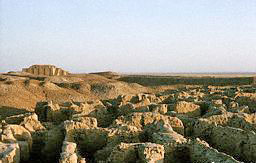
Ziggurat and
ruin Walls of the ancient Sumerian city of Ur, in
modern-day Iraq. |
Inanna and Utu.... Zu/Sinís Children....
"The two were born to Sin by his official spouse Ningal, and were
thus by birth members of the Divine Dynasty. Inanna was technically
the firstborn, but her twin brother, Utu, was the firstborn son, and
thus the legal dynastic heir.
"Inanna and Utu were born in time immemorial,
when only the gods
inhabited the Earth. Utuís city-domain Sippar was listed among the
very first cities to have been established by the gods in Sumer.
"When civilization blossomed in Sumer, and Man joined the gods in
the Land Between the Rivers, Utu became associated primarily with
law and justice. Several early law codes, apart for invoking Anu and
Enlil, were also presented as requiring acceptance and adherence
because they were promulgated "in accordance with the true word of
Utu". The Babylonian King Hammurabi inscribed his law code in a
stela, at the top of which the king is depicted receiving the laws
from the god.
"The justice advocated by Utu is reminiscent of the
Sermon of the
Mount recorded in the New Testament. A "wisdom tablet" suggested the
following behavior to please Utu:
Unto your opponent do no evil;
Your evildoer recompense with good.
Unto your enemy, let justice be done....
Let not your heart be induced to do evil....
To the one begging for alms -
give food to eat, give wine to drink....
Be helpful, do good.
"....Hammurabi, in his inscription called the god by his Akkadian
name, Shamash, which in Semitic languages means "Sun." It has
therefore been assumed by the scholars that Utu/Shamash was the
Mesopotamian Sun God. We shall show, as we proceed, that while this
god was assigned the Sun as his celestial counterpart, there was
another aspect to the statements that "he shed a bright light" when
he performed the special tasks assigned to him by his grandfather Enlil."
"Just as the law codes and the court records are human testimonials
to the actual presence among the ancient peoples of Mesopotamia of a
deity named Utu/Shamash, so there exist endless inscriptions, texts,
incantations, oracles, prayers, and depictions attesting to the
physical presence and existence of the goddess Inanna, whose
Akkadian name was Ishtar."
"....Known to the Romans as
Venus, to the Greeks as Aphrodite, to
the Canaanites and the Hebrews as Ashtarte, to the Assyrians and
Babylonians and Hittites and the other ancient peoples as Ishtar or
Eshdar, to the Akkadians and the Sumerians as Inanna or
Innin or
Ninni."
"....Her nicknames and epithets, she was at all times the
Goddess of
Warfare and the Goddess of Love, a fierce, beautiful woman who,
though only a great-granddaughter of Anu, carved for herself, by
herself, a major place among the Great Gods of Heaven and Earth."
"....Her occupation of Anuís temple in Uruk could not have taken
place without his knowledge and consent; and the texts give us
strong clues as to how such consent was obtained. Soon Inanna was
known as "Anunitum," a nickname meaning "beloved of
Anu."
"....Having thus maneuvered herself into the position of goddess of
Uruk and mistress at the temple of Anu, Ishtar proceeded to use
trickery for enhancing Urukís standing and her own powers. Farther
down the Euphrates stood the ancient city of Eridu -
Enkiís center.
Knowing of his great knowledge of all the arts and sciences of
civilization, Inanna resolved to beg, borrow, or steal these
secrets.
Inanna arranged for a meeting with
Enki:
"....Happy and drunk,
Enki was ready to do anything for Inanna. She
boldly asked for the divine formulas, which were the basis of a high
civilization. Enki granted her some one hundred of them, including
divine formulas pertaining to supreme lordship, Kingship, priestly
functions, weapons, legal procedures, scribe-ship, woodworking, even
the knowledge of musical instruments and of temple prostitution. By
the time Enki awoke and realized what he had done, Inanna was
already well on her way to Uruk. Enki ordered after her his "awesome
weapons," but to no avail, for Inanna had sped to Uruk in her "Boat
of Heaven."
|
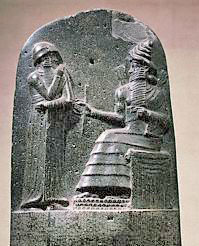
Stele of
Hammurabi. This bas-relief sculpture depicts King
Hammurabi receiving the law from Shamash, the Sun God.
|
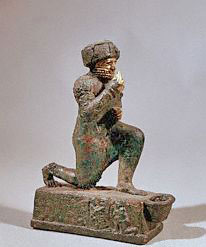
King
Hammurabi in Prayer
|
|
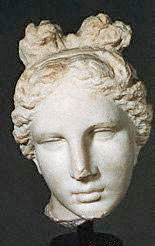
Classical
Greek Sculptured Head of Aphrodite |
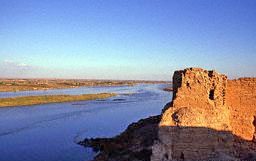
Euphrates
River, crossing Syria.
|
The Sons of the Gods.... Their
allotted numbers.... The Anunnaki....
"Of the six known sons of
Enki, three have been featured in Sumerian
tales: the firstborn Marduk, who eventually usurped the supremacy;
Nergal, who became ruler of the Lower World and Dumuzi, who married
Inanna/Ishtar.
"Enlil, too, had three sons who played three roles in both divine
and human affairs: Ninurta, who, having been born to Enlil by his
sister Ninhursag, was the legal successor; Nanna/Sin firstborn by
Enlilís official spouse Ninlil, and a younger son by
Ninlil named
ISH.KUR ("mountainous," "far mountain land") who was more frequently
called Adad ("beloved").
"....The greatest affinity seems to have existed between
Adad and
Ishtar.
"....But Ishkur was not only a playboy; he was a mighty god, endowed
by his father Enlil with the powers and prerogatives of a storm
god. As such he was revered as the Hurrian/Hittite Teshub and the
Urartian Teshubu ("wind blower"), the Amorite Ramanu ("thunderer"),
the Canaanite Ragimu ("caster of hailstones"), the Indo-European
Buriash ("light maker"), the Semitic Meir ("he who lights up" the
skies).
"....The position of the sons of Anu, Enlil, and
Enki, and of their
offspring, in the dynastic lineage emerges clearly through a unique
Sumerian device: the allocation of numerical rank to certain gods.
The discovery of this system also brings out the membership in the
Great Circle of the Gods of Heaven and Earth when Sumerian
civilization blossomed. We shall find that this Supreme Pantheon was
made up of twelve deities.
"....The first hint that a cryptographic number system was applied
to the Great Gods came with the discovery that the names of the gods
Sin, Shamash, and Ishtar were sometimes substituted in the texts by
the numbers 30, 20, and 15, respectively. The highest unit of the
Sumerian sexagesimal system - 60 - was assigned to Anu; Enlil "was"
50; Enki, 40; and Adad, 10. The number 10 and its six multiples
within the prime number 60 were thus assigned to male deities, and it
would appear plausible that the numbers ending with 5 were assigned
to the female deities.
"....There were many other gods in Sumer - children, grandchildren,
nieces, and nephews of the Great Gods; there were also several
hundred rank-and-file gods, called Anunnaki, who were assigned (one
may say) "general duties," but only twelve made it to the Great
Circle."
Mr. Sitchin presents charts of these various other gods in his book
"The 12th Planet."
Return
Chapter Five
THE NEFILIM:
PEOPLE OF THE FIERY ROCKETS
"Sumerian and Akkadian texts leave no doubt that the peoples of the
ancient Near East were certain that the Gods of Heaven and Earth
were able to rise from Earth and ascend into the heavens, as well as
roam Earthís skies at will."
Inanna, was one who could roam "the heavens over many lands that lie
far apart - feats only possible by flying."
"...Such a capability, by
Inanna as well as the other major gods,
was often indicated by the ancient artists by depicting the gods -
anthropomorphic in all other respects as we have seen - with wings.
The wings as can be seen from numerous depictions, were not of the
body - not natural wings, but rather a decorative attachment to the
godís clothing.
"....Her most celebrated journey was to the Lower World, the domain
of her sister Ereshkigal. The journey was not only the subject of
epic tales but also of artistic depictions on cylinder seals - the
latter showing the goddess with wings, to stress the fact that she
flew over from Sumer to the Lower World.
"....The texts dealing with this hazardous journey describe how
Inanna very meticulously put on herself seven objects prior to the
start of the voyage, and how she had to give them up as she passed
through the seven gates leading to her sisterís abode. Seven such
objects are also mentioned in other texts dealing with Inanna
skyborne travels:
1. The SHU.GAR.RA she put on her head.
2. "Measuring pendants," on her ears.
3. Chains of small blue stones, around her neck.
4. Twin "stones," on her shoulders.
5. A golden cylinder, in her hands.
6. Straps, clasping her breast.
7. The PALA garment, clothed around her body.
"Though no one has as yet been able to explain the nature and
significance of these seven objects, we feel that the answer has
long been available. Excavating the Assyrian capital Assur from 1903
to 1914, Walter Andrae and his colleagues found in the Temple of Ishtar a battered statue of the goddess showing her with various
"contraptions" attached to her chest and back. In 1934
archaeologists excavating at Mari came upon a similar but intact
statue buried in the ground. It was a life-size likeness of a
beautiful woman. Her unusual headdress was adorned with a pair of
horns, indicating that she was a goddess. Standing around the 4,000
years old statue, the archaeologists were thrilled by her lifelike
appearance (in a snapshot, one can hardly distinguish between the
statue and the living men). They named her The Goddess with a Vase
because she was holding a cylindrical object.
"Unlike the flat carvings or bas-reliefs, this life-size,
three-dimensional representation of the goddess reveals interesting
features about her attire. On her head she wears not a millinerís
chapeau but a special helmet; protruding from it on both sides and
fitted over the ears are objects that remind one of a pilotís
earphones. On her neck and upper chest the goddess wears a necklace
of many small (and probably precious) stones; in her hands she holds
a cylindrical object which appears too thick and heavy to be a vase
for holding water.
"Over a blouse of see-through material, two parallel straps run
across her chest, leading back to and holding in place an unusual
box of rectangular shape. The box is held tight against the back of
the goddessís neck and it is firmly attached to the helmet with a
horizontal strap. Whatever the box held inside must have been heavy,
for the contraption is further supported by two large shoulder pads.
The weigh of the box is further increased by a hose that is
connected to its base by a circular clasp. The complete package of
instruments - for this is what they undoubtedly were - is held in
place with the aid of the two set of straps that crisscross the
goddessís back and chest.
"The parallel between the seven objects required by
Inanna for her
aerial journeys and the dress and objects worn by the statue from
Mari (and probably also the mutilated one found at
Ishtarís temple
in Ashur) is easily proved. We see the "measuring pendants" - the
earphones - on her ears; the rows or "chains" of small stones around
her neck; the "twin stones" - the two shoulder pads - on her
shoulders; the "golden cylinder" in her hands, and the clasping
straps that crisscross her breast.
She is indeed clothed in a "PALA
garment" ("rulerís garment"), and on her head she wears the
SHU.GAR.RA helmet - a term that literally means "that which makes go
far into the universe." All this suggests to us that the attire of
Inanna was that of an astronaut.
|
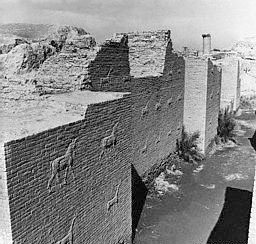
Ishtar Gate
|
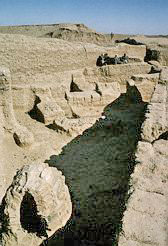
Excavated
Ruins at the Ancient City of Mari |
The Nefilim.... Angels.... Emissaries.... Temples, enclosures for
the "divine bird"
"....Jacob saw them going up a sky ladder,
Hagar (Abrahamís
concubine) was addressed by them from the sky, and it was them who
brought about the aerial destruction of Sodom and Gomorrah.
"....We learn that their appearance was sudden.
Abraham "raised his
eyes and lo and behold, there were three men standing by him."
Bowing and calling them "My Lords," he pleaded with them, "Do not
pass over thy servant" and prevailed on them to wash their feet,
rest, and eat.
"Having done as Abraham had requested, two of the
angels (the third
"man" turned out to be the Lord himself) then proceeded to
Sodom.
Lot the nephew of
Abraham also invited them to the house offering to
wash their feet, an overnight stay, and feed them.
Mr. Sitchin asks a good question:
"How were these men - who ate, drank, slept, and washed tired feet -
nevertheless so instantly recognizable as angels of the Lord? The
only plausible explanation is that what they wore - their helmets or
uniforms - or what they carried - their weapons - made them
immediately recognizable. That they carried distinctive weapons is
certainly a possibility. The two "men" at Sodom, about to be lynched
by the crowd, "smote the people at the entrance of the house with
blindness.... and they were unable to find the doorway."
Referring once again to
Ishtar/Inanna:
"The team headed by
Andrea found yet another unusual depiction of Ishtar at her temple at
Ashur. More a wall sculpture than the usual
relief, it showed the goggles with a tight-fitting decorated helmet
with the "earphones" extended as though they had their own flat
antennas, and wearing very distinct goggles that were part of the
helmet.
Needles to say, any man seeing a person - male or female - so clad,
would at once realize that he is encountering an aeronaut.
"About two millennia earlier, when Sumerian ruler
Gudea commemorated
his building the temple for his god Ninurta, he wrote that there
appeared to him "a man that shone like Heaven.... by the helmet on
his head, he was a god." When Ninurta and two divine companions
appeared to Gudea, they were standing beside Ninurtaís "divine black
wind bird." As it turned out, the main purpose of the templeís
construction was to provide a secure zone, an inner special
enclosure within the temple grounds, for this "divine bird."
"The ancient texts also describe some vehicle used to lift
aeronauts
into the skies.
"....The protected enclosure was described as
MU.NA.DA.TUR.TUR
("strong stone resting place of the MU"). Urukagina who ruled in
Lagash, said in regard to the "divine black wind bird": "The
MU that
lights up as a fire I made high and strong."
"Similarly,
Lu-Utu, who ruled in Umma in the third millennium B.C.,
constructed a place for a mu, "which in a fire comes forth, "for the
god Utu, in the appointed place within his temple."
"....That a
mu - an oval topped, conical object - was indeed
installed in the inner, sacred enclosure of the temples of the Great
Gods of Heaven and Earth can, fortunately, be proved. An ancient
coin found at Byblos (the Biblical Gebal) on the Mediterranean coast
of present - day Lebanon depicts the Great Temple of Ishtar."
Mr. Sitchin has dedicated a whole page to describe this coin in his
book The 12th Planet.
"....A hymn to
Inanna/Ishtar and her journeys in the Boat of Heaven
clearly indicates that the mu was the vehicle in which the gods
roamed the skies far and high:
Lady of Heaven:
She puts on the Garment of Heaven;
She valiantly ascends towards Heaven.
Over all the people lands
she flies in her Mu
Lady, who in her Mu
to the heights of Heaven joyfully wings.
Over all the resting places
she flies in her Mu.
"There is evidence to show that the people of the eastern
Mediterranean had seen such a rocket-like object not only in a
temple enclosure but actually in flight. Hittite glyphs, for
example, showed - against a background of starry heavens - cruising
missiles, rockets mounted on launch pads, and a god inside a
radiating chamber.
"....Indeed, a rocket with "wings" or fins - reachable by a "ladder"
- can be seen on a tablet excavated at Gezer, a town in ancient
Canaan, west of Jerusalem. The double imprint of the same seal also
shows a rocket resting on the ground next to a palm tree. The
celestial nature or destination of the objects is attested by
symbols of the Sun, Moon, and zodiacal constellations that adorn the
seal."
|
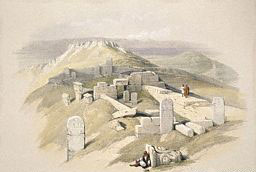
An ancient
Egyptian Temple on Gebel Garabe. |
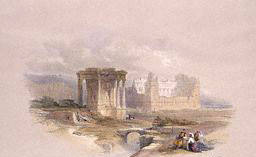
Ancient
Watchtower, Circular Temple of Venus, Lebanon |
|
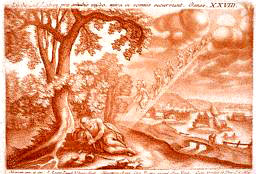
Jacobís
Ladder, the biblical version. |
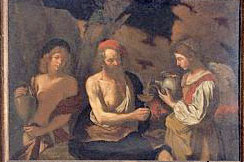
Lot and his
Daughters, by Bartolomeo Manfredi |
|
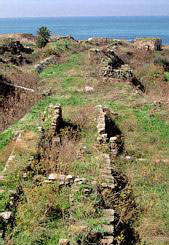
Ruins of the
ancient Phoenician seaport of Byblos. |
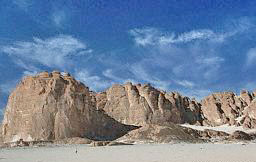
A view of
cliffs in the Sinai desert near Gebel (Mount) Baraka.
Egypt
|
The Nefilim....
Mu.... Shu-Mu.... Sham, or Shem....
"The Mesopotamian texts that refer to the inner enclosures of
temples, or to the heavenly journeys of the gods, or even to
instances where mortals ascended to the heavens, employ the Sumerian
term mu or its Semitic derivatives shu-mu ("that which is a mu"), sham, or shem. Because the term also connoted "that by which one is
remembered," the word has come to be taken as meaning "name." But
the universal application of "name" to early texts that spoke of an
object used in flying has obscured the true meaning of the ancient
records.
"....Wishing to worship their gods throughout the lands, and not
only at the official "house" of each deity, the ancient peoples
developed the custom of setting up imitations of the god within his
divine "sky chamber." Some pillars shaped to simulate the oval
vehicle were erected at selected sites, and the image of the god was
carved into the stone to indicate that he was within the object.
"....The Sumerians called them NA.RU ("stones that rise"). The
Akkadians, Babylonians, and Assyrians called them naru ("objects
that give off light"). The Amuru called them nuras ("fiery objects"-
in Hebrew, ner still means a pillar that emits light, and thus
todayís "candle"). In the Indo-European tongues of the Hurrians and
the Hittites, the stelae were called hu-u-ashi ("fire bird of
stone").
"....The realization that mu or
shem in many Mesopotamian texts
should be read not as a "name" but as "sky vehicle" opens the way to
the understanding of the true meaning of many ancient tales,
including the biblical story of the Tower of Babel.
After pages of research on the
Tower of Babel, Mr. Sitchin writes:
"There is little doubt now that the biblical tales, as well as the
reports of the Greek historians of 2,000 years ago and on their
predecessor Berossus, all stem from earlier - Sumerian - origins.
A.H. Sayce (The Religion of the Babylonians) reported reading on a
fragmentary tablet in the British Museum "the Babylonian version of
the building of the Tower of Babel." In all instances, the attempt
to reach the heavens and the ensuing confusion of tongues are basic
elements of the version. There are other Sumerian texts that record
the deliberate confusion of Manís tongue by an irate god.
"Mankind, presumably, did not possess at that time the technology
required for such an aerospace project; the guidance and
collaboration of a knowledgeable god was essential. Did such a god
defied the others to help Mankind? A Sumerian seal depicts a
confrontation between armed gods, apparently over the disputed
construction by men of a stage tower.
"....Both the Mesopotamian texts and the biblical account impart the
same moral: The flying machines were meant for the gods and not for
Mankind."
"Men - assert both Mesopotamian and biblical texts - could ascend to
the Heavenly Abode only upon express wish of the gods. And therein
lie more tales of ascents to the heavens and even of space flights.
The first was Enoch. The other mortal was the prophet
Elijah.
"....A little-known reference to a third mortal who visited the
Divine Abode and was endowed there with great wisdom is provided in
the Old Testament, and it concerns the ruler or Tyre (a Phoenician
center on the eastern Mediterranean coast).
"We read in the
Book of Ezequiel, Chapter 28 that the Lord commanded
the prophet to remind the king how, perfect and wise, he was enabled
by the Deity to visit with the gods:
Thou art molded by a plan,
full of wisdom, perfect in beauty.
Thou hast been in Eden, the Garden of God;
every precious stone was thy thicket....
Thou art an anointed Cherub, protected;
and I have placed thee in the sacred mountain;
as a god werest thou,
moving within the Fiery Stones.
"The Sumerian texts also speak of several men who were
privileged
to ascend to the heavens. One was Adapa, the "model man" created by
Ea. To him Ea "had given wisdom; eternal life he had not given him."
As the years went by, Ea decided to avert Adapaís mortal end by
providing him with a shem with which he was to reach the
Heavenly
Abode of Anu, there to partake of the Bread of Life and the Water of
Life.
When Adapa arrived at Anuís Celestial Abode,
Anu demanded to
know who had provided Adapa with a shem with which to reach the
heavenly location.
|
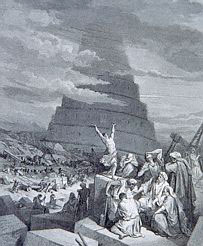
Engraving ot
Tower of Babel, by Dore 1866. From Doreís Bible.
|
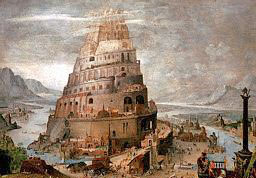
The
Construction of the Tower of Babel. |
|
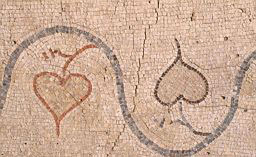
A floor
mosaic from the ancient Phoenician city of Tyre, south
of Lebanon |
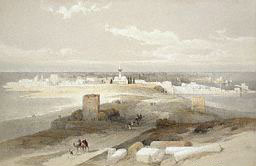
Tyre, viewed
from the isthmus |
|
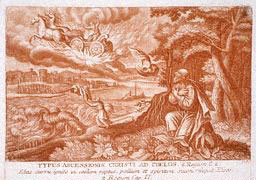
Elijah
ascends to heaven... watched by Elisha, who remains on
Earth as next prophet. |
The Epic of
Gilgamesh.....
"The futile search by mortal
Man for the Tree of Life is the subject
of one of the longest, most powerful epic texts bequeathed to human
culture by the Sumerian civilization. Named by modern scholars "The
Epic of Gilgamesh" the moving tale concerns the ruler of Uruk who
was born to a mortal father and a divine mother. As a result, Gilgamesh was considered to be "two-thirds of him god, one-third of
him human," a circumstance that prompted him to seek escape from the
death that was the fate of mortals.
"Tradition had informed him that one of his forefathers,
Utnapishtim
- the hero of the Deluge - had escaped death, having been taken to
the Heavenly Abode together with his spouse. Gilgamesh therefore
decided to reach that place and obtain from his ancestors the secret
of eternal life.
"....The "distant journey" Gilgamesh undertook was, of course, his
journey to the Abode of the Gods; he was accompanied by his comrade
Enkidu. Their target was the Land of Tilmun, for there
Gilgamesh
could raise a shem for himself. The current translations employ the
expected "name" where the Sumerian mu or the Akkadian shumu appear
in the ancient texts; we shall, however, employ shem instead so that
the termís true meaning - a "skyborne vehicle" - will come through.
Several verses of the Epic appear on the book The 12th Planet, which
describe the launching of a rocket ship.
"....Putting aside the literary and philosophic values of the epic
tale, the story of Gilgamesh interests us here primarily for its
"aerospace" aspects. The shem that Gilgamesh required in order to
reach the Abode of the Gods was undoubtedly a rocket ship, the
launching of one of which he had witnessed as he neared the "landing
place." The rockets, it would seem, were located inside a mountain,
and the area was a well guarded, restricted zone.
"No pictorial depiction of what
Gilgamesh saw has so far come to
light. But a drawing found in the tomb of an Egyptian governor of a
far land shows a rocket-head above ground in a place where date trees
grow. The shaft of the rocket is clearly stored underground, in a
man-made silo constructed of tubular segments and decorated with
leopard skins....
"....We can see that the rocket contained a number of compartments.
The lower one shows two men surrounded by curving tubes. Above them
there are three circular panels. Comparing the size of the
rocket-head - the ben-ben - to the size of the two men inside the
rocket, and the people above the ground, it is evident that the
rocket-head - equivalent to the Sumerian mu, the "celestial chamber"
- could easily hold one or two operators or passengers.
"TIL.MUN was the name of the land to which
Gilgamesh set his course.
The name literally meant "land of the missiles." It was the land
where the shemís were raised, a land under the authority of Utu/Shamash,
a place where one could see this god "rise up to the vaults of
heaven."
"And though the celestial counterpart of this member of the
Pantheon
of Twelve was the Sun, we suggest that his name did not mean "Sun"
but was an epithet describing his functions and responsibilities.
His Sumerian name Utu meant "he who brilliantly goes in." His
derivate Akkadian name - Shem-Esh - was more explicit:
Esh means
"fire," and we know now what shem originally meant.
"Utu/Shamash was "he of the fiery rocket ships." He was, we suggest,
the commander of the spaceport of the gods.
Etana.... Thirteenth
Ruler of Kish.... The Eagle.... Our Modern Astronauts....
"The Sumerian king lists inform us that the thirteenth ruler of Kish
was Etana, "the one who to heaven ascended."
"....Etana, we are told, was designated by the gods to bring Mankind
the security and prosperity that Kingship - an organized
civilization - was intended to provide. But Etana it seems could not
further a son who would continue the dynasty. The only known remedy
was a certain known Plant of Birth that Etana could obtain only by
fetching down from the heavens.
"Like Gilgamesh at a later time,
Etana turned to Shamash for
permission and assistance. As the epic unfolds it becomes clear that
Etana was asking Shamash for a shem!
Oh Lord, may it issue from thy mouth!
Grant thou me the Plant of Birth!
Show me the Plant of Birth!
Remove my handicap!
Produce for me a shem!
"....But instead of speaking of a
shem, Shamash told Etana that an
"eagle" would take him to the desired heavenly place.
"Directing Etana to the pit where the Eagle had been placed,
Shamash
also informed the Eagle ahead of time of the intended mission.
"....Arriving at the mountain indicated to him by Shamash, "Etana
saw the pit," and, inside it, "there the Eagle was." "At the command
of valiant Shamash, "the Eagle entered into communication with
Etana.
Once more, Etana explained his purpose and destination; whereupon
the Eagle began to instruct Etana on the procedure for "raising the
Eagle from its pit." The first two attempts failed, but on the third
one the Eagle was properly raised. At daybreak, the Eagle announced
to Etana: "My friend ... up to the Heaven of Anu I will bear thee!"
".... As though reported by a modern astronaut watching Earth recede
as his rocket ship rises, the ancient story teller describes how
Earth appeared smaller and smaller to Etana:
When he had borne him aloft one beru,
the Eagle says to him, to Etana:
"See, my friend, how the land appears!
Peer at the sea at the sides of the Mountain House:
The land has indeed become a mere hill,
The wide sea is just like a tub."
And so goes the epic until the land had disappeared.
"....The tale of
Etana informs us that, seeking a shem, Etana had to
communicate with an Eagle inside a pit. A seal depiction shows a
winged, tall structure (a launch tower?) above which an eagle flies
off.
"What or who was the Eagle who took Etana to the distant heavens?
"We cannot help associating the ancient text with the message beamed
to Earth in July 1969 by Neil Armstrong, commander of the Apollo 11
spacecraft: "Houston! Tranquility Base here. The Eagle has landed!"
He was reporting the first landing by
Man on the Moon. "Tranquility
Base" was the site of the landing: Eagle was the name of the lunar
module that separated from the spacecraft and took the two
astronauts inside it to the Moon (and then back to their mother
craft). When the lunar module first separated to start its own
flight in Moon orbit, the astronauts told Mission Control in
Houston:
"The Eagle has wings."
"But Eagle could also denote the astronauts who manned the
spacecraft. On the Apollo 11 mission, "Eagle" was also
the symbol of
the Astronauts themselves, worn as an emblem on their suits. Just as
in the Etana tale, they, too, were "Eagles" who could fly, speak and
communicate.
"How would an ancient artist have depicted the pilots of the
skyships of the gods? Would he have depicted them, by some chance,
as eagles? Thatís exactly what we have found. An Assyrian seal
engraving from circa 1500 B.C. shows two "eagle-men" saluting a
shem!
"....The many depictions of the Eagles clearly show that they were
not monstrous "bird-men", but anthropomorphic beings wearing
costumes or uniforms that gave them the appearance of eagles.
"....The Mesopotamian texts invariable present Utu/Shamash as the
god in charge of the landing place of the shemís and of the Eagles.
And like his subordinates he was sometimes shown wearing the full
regalia of an Eagleís costume.
Mr. Sitchin after presenting a series of sketches of the ancient
rocket-ships, and explanations of the same, taken from various
Temples, of Utu, and Anu, concludes:
"The evidence thus far submitted regarding the
ancient gods and
their vehicles should leave no further doubt that there were once
indeed living beings of flesh and blood , people who literally came
down to Earth from the heavens.
In the Old Testament.
"Even the ancient compilers of the Old Testament - who dedicated the
Bible to a single God - found it necessary to acknowledge the
presence upon Earth in early times of such divine beings.
"The enigmatic section - one of
horror of translators and
theologians alike - form the beginning of chapter 6 of Genesis. It
is interposed between the review of the spread of Mankind through
the generations following Adam and the story of the divine
disenchantment with Mankind that preceded the Deluge. It states -
unequivocally - that, at that time,
the sons of the gods
saw the daughters of man, that they were good;
and they took them for wives,
of all which they chose.
The Nefilim were upon the Earth,
in those days and thereafter too,
when the sons of the gods
cohabited with the daughters of the Adam,
and they bore children unto them.
They were the mighty ones of Eternity -
The People of the shem.
"The above is not a traditional
translation. For a long time, the
expression "The Nefilim were upon the Earth" has been translated as
"There were giants upon the earth;" but recent translators,
recognizing the error, have simply resorted to leaving the Hebrew
term Nefilim intact in the translation. The verse "The people of the
shem," as one could expect, has been taken to mean "the people who
have a name," and, thus, "the people of renown." But as we have
already established, the term shem must be taken in its original
meaning - a rocket, a rocket ship.
"....Irrespective of the theological implications, the literal and
original meaning of the verses cannot be escaped: The sons of the
gods who came to Earth from the heavens were the Nefilim.
And the Nefilim were the
People of the Shem - the People of the
Rocket Ships. Henceforth, we shall call them by their biblical name."
Return
|

















